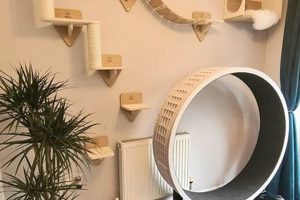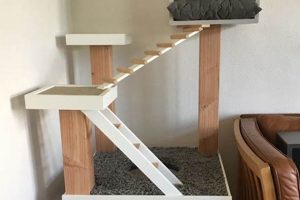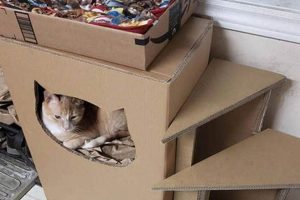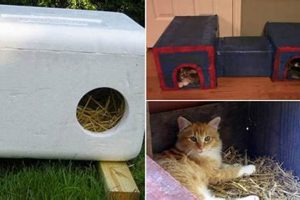A self-constructed, insulated shelter designed to provide warmth for felines, particularly during colder months, is a beneficial project for animal welfare. Such a structure often incorporates a safe and regulated heating element to maintain a comfortable temperature inside. For instance, individuals might repurpose existing materials like plastic storage containers or wooden pallets to create a suitable enclosure and integrate a low-wattage heating pad or a self-regulating pet-safe heater.
Providing supplemental warmth to outdoor or stray felines during periods of inclement weather is vital for their health and well-being. These shelters mitigate the risks associated with hypothermia and frostbite. Historically, concerned citizens have taken initiative to protect vulnerable animals from harsh environmental conditions. Constructing these dwellings allows individuals to directly contribute to the safety and survival of animals in their communities.
The following sections will outline appropriate material selection, construction techniques, safety considerations, and heating options to facilitate the building of a proper feline shelter. Careful attention to these details will ensure the creation of a safe and effective haven for cats.
Construction Tips for Heated Feline Shelters
Effective construction requires careful planning and adherence to safety guidelines to ensure a warm and secure environment for cats.
Tip 1: Insulate Thoroughly: Prioritize insulation within the shelter’s walls, floor, and roof. Expanded polystyrene (EPS) foam or rigid fiberglass insulation provide effective thermal barriers. Secure the insulation to prevent exposure to the animal.
Tip 2: Choose Weather-Resistant Materials: Select exterior materials capable of withstanding environmental conditions. Treated wood or durable plastics offer protection against rain, snow, and wind. Ensure all materials are non-toxic and safe for animal contact.
Tip 3: Implement a Safe Heating System: Employ a low-wattage, pet-safe heating pad or a self-regulating heater specifically designed for animal use. Avoid using human heating blankets or unsecured heating elements due to potential fire hazards and electrical shock risks.
Tip 4: Elevate the Shelter: Raise the structure slightly off the ground to prevent moisture accumulation and improve insulation. Utilize bricks or wooden supports to elevate the base, ensuring stability.
Tip 5: Provide a Windbreak: Design the entrance with an overhang or tunnel to minimize wind exposure. A strategically placed barrier will reduce drafts and maintain a stable internal temperature.
Tip 6: Monitor Temperature Regularly: During extreme weather, check the internal temperature of the shelter to ensure it remains within a comfortable range. Use a remote thermometer to avoid disturbing the occupant.
Tip 7: Ensure Adequate Ventilation: While insulation is crucial, provide small ventilation holes to prevent moisture buildup and ensure air circulation. Position the vents away from prevailing winds to avoid drafts.
Following these guidelines results in a durable, insulated, and safe enclosure, contributing significantly to the well-being of outdoor cats during harsh weather conditions.
The subsequent section will cover maintenance procedures and long-term considerations for ensuring the continued effectiveness of the shelter.
1. Insulation Effectiveness
The effectiveness of insulation is a primary determinant in the thermal performance of a do-it-yourself heated cat house. Proper insulation minimizes heat loss, thereby reducing the energy required to maintain a comfortable internal temperature for the animal, particularly during periods of low ambient temperatures. The selection and implementation of insulation materials directly impact the shelter’s ability to provide a refuge from the cold.
- Material Thermal Resistance
The R-value, a measure of thermal resistance, is a critical factor in insulation selection. Higher R-values indicate greater insulating capability. For instance, closed-cell spray foam provides a high R-value per inch of thickness, minimizing space intrusion while maximizing heat retention. Conversely, less effective materials necessitate thicker applications, potentially reducing the usable interior space of the shelter. Appropriate material selection, based on R-value and space constraints, is paramount.
- Air Leakage Reduction
Effective insulation strategies extend beyond material selection to include meticulous sealing of air gaps. Air leakage undermines the performance of even high R-value insulation. Caulking and weather stripping should be employed to seal seams and joints in the structure. Preventing drafts is essential for maintaining a stable internal temperature. The minimization of air infiltration directly correlates with the shelter’s ability to conserve heat.
- Moisture Management
The presence of moisture within insulation materials significantly reduces their thermal resistance. Condensation can form due to temperature differentials between the inside and outside of the shelter. A vapor barrier, strategically placed on the warmer side of the insulation, mitigates moisture penetration. Proper moisture management preserves the insulation’s effectiveness and prevents the growth of mold or mildew, which can compromise the animal’s health.
- Long-Term Performance
The durability and degradation rate of insulation materials impact their long-term effectiveness. Some materials, such as fiberglass batts, may settle over time, reducing their insulating capacity. Materials resistant to compression, such as rigid foam boards, maintain their performance characteristics for extended periods. Selecting materials with demonstrated longevity ensures consistent thermal protection for the animal throughout the shelter’s lifespan.
These factors collectively determine the insulation effectiveness of a constructed feline shelter. Optimizing each aspect ensures that the shelter provides efficient thermal protection, minimizing energy consumption and maximizing the animal’s comfort. The careful consideration of material properties, air sealing, moisture management, and long-term performance are crucial elements in designing and building shelters. These design elements have a substantial contribution to the animal comfort in the winter.
2. Heating system safety
Heating system safety is paramount when constructing a self-made heated cat house. A poorly designed or implemented heating system can pose significant risks to the animal, including burns, electrocution, and fire. Therefore, careful consideration of safety protocols and component selection is essential to mitigate these hazards.
- Low-Voltage Operation
Employing low-voltage heating elements, typically 12V or 24V, significantly reduces the risk of electrical shock. These systems operate at voltages that are unlikely to cause serious harm in the event of contact. A transformer is used to step down the standard household voltage to the safer low-voltage level. The use of low-voltage systems minimizes the potential for injury to the animal.
- Overcurrent Protection
Integrating overcurrent protection devices, such as fuses or circuit breakers, is crucial for preventing overheating and potential fires. These devices interrupt the electrical circuit if the current exceeds a safe level. Selecting appropriately rated fuses or breakers, based on the heating element’s power consumption, safeguards against equipment malfunction and fire hazards. Overcurrent protection adds a crucial layer of safety.
- Temperature Regulation
Implementing a temperature regulation system, such as a thermostat, prevents overheating by maintaining a consistent and safe temperature within the shelter. A thermostat monitors the internal temperature and automatically adjusts the power supplied to the heating element. This prevents the shelter from becoming excessively hot, which can cause discomfort or burns to the animal. Temperature regulation is vital for ensuring a comfortable and safe environment.
- Enclosure Integrity
Ensuring that all electrical components are fully enclosed and protected from the animal prevents direct contact and minimizes the risk of damage or tampering. Wiring should be securely routed and protected with conduit or other suitable materials. The heating element should be housed in a durable, non-conductive enclosure to prevent accidental contact. Maintaining the integrity of the electrical enclosure is essential for safety.
The implementation of these safety measureslow-voltage operation, overcurrent protection, temperature regulation, and enclosure integrityis integral to the responsible construction of a heated cat house. The selection of certified components along with stringent adherence to electrical safety standards contributes to a functional and safe environment for the animal. These procedures substantially reduce the risk of electrical-related incidents.
3. Weatherproof construction
Weatherproof construction is a foundational element in the effective design and implementation of a feline shelter. Without adequate protection from environmental elements, a shelter’s intended purpose of providing warmth and safety is significantly compromised. The integration of weatherproof features is crucial for ensuring the structure’s longevity and the animal’s well-being.
- Material Selection and Water Resistance
The choice of construction materials directly impacts the shelter’s ability to withstand moisture. Untreated wood, for instance, is susceptible to rot and decay, rendering it unsuitable for outdoor use. Pressure-treated lumber, durable plastics, or metal offer superior water resistance. The application of waterproof coatings or sealants further enhances protection against moisture penetration, extending the lifespan of the structure.
- Roof Design and Water Runoff
The roof’s design plays a critical role in directing water away from the shelter’s interior. A sloped roof facilitates efficient water runoff, preventing accumulation and potential leaks. Overhanging eaves provide additional protection by shielding the walls from direct rainfall. Proper roof design minimizes water damage and maintains a dry interior environment for the animal.
- Sealed Seams and Joint Integrity
Seams and joints represent vulnerable points for water ingress. Employing waterproof sealants and adhesives effectively closes gaps and prevents water from penetrating the structure. Proper sealing techniques ensure that the shelter remains watertight, even during periods of prolonged rainfall. Maintaining the integrity of seams and joints is essential for long-term weatherproof performance.
- Elevated Base and Ground Moisture Barrier
Elevating the shelter off the ground mitigates moisture absorption from the surrounding soil. A raised base prevents direct contact with wet surfaces, reducing the risk of rot and decay. Incorporating a ground moisture barrier, such as a sheet of plastic or rubber, further protects the structure from ground moisture. An elevated base and moisture barrier contribute to a dry and stable shelter environment.
These facets of weatherproof construction collectively ensure that a feline shelter provides reliable protection from the elements. By prioritizing water resistance, roof design, seam integrity, and ground moisture protection, builders can create a durable and effective haven for animals, enhancing their safety and comfort. Furthermore, consideration of these elements contributes to the long-term viability and performance of the shelter.
4. Proper ventilation
Proper ventilation is an indispensable element within a self-constructed heated feline shelter. Ventilation mitigates the accumulation of moisture and the build-up of potentially harmful gases, thereby safeguarding the animal’s respiratory health and ensuring a comfortable environment. An absence of adequate ventilation can result in condensation, mold growth, and a compromised air quality, negating the benefits of the shelter.
- Moisture Control
Ventilation facilitates the removal of moisture generated by the animal’s respiration and metabolic processes. Condensation, which can form on interior surfaces due to temperature differentials, is effectively reduced through air circulation. The removal of moisture prevents the saturation of insulation materials, preserving their thermal performance. Damp environments foster the growth of mold and mildew, posing respiratory risks to the feline occupant. Adequate ventilation, therefore, controls humidity levels and promotes a dry and healthy internal environment.
- Air Quality Management
Feline respiration releases carbon dioxide and other gases into the enclosed space. Inadequate ventilation can lead to a buildup of these gases, potentially causing discomfort or respiratory distress. Moreover, the degradation of certain building materials can release volatile organic compounds (VOCs) that negatively impact air quality. Ventilation introduces fresh air, diluting the concentration of these contaminants and maintaining a breathable atmosphere. Fresh airflow minimizes the risks associated with poor air quality.
- Temperature Regulation Assistance
While the primary heating mechanism maintains warmth, ventilation can contribute to temperature regulation within the shelter. During periods of warmer weather, limited ventilation allows for the dissipation of excess heat, preventing the shelter from becoming excessively hot. Strategic placement of ventilation openings enables cross-ventilation, promoting airflow and minimizing temperature stratification. Ventilation, in conjunction with insulation, aids in maintaining a stable and comfortable internal temperature range.
- Draft Mitigation Techniques
While ventilation is necessary, excessive drafts can negate the benefits of the shelter’s insulation and heating system. The design should incorporate draft mitigation techniques, such as baffles or strategically positioned ventilation openings, to minimize the direct flow of cold air onto the animal. Ventilation openings should be small and located in areas that minimize exposure to prevailing winds. Balancing the need for fresh air with the prevention of drafts is critical for maintaining a comfortable environment.
The implementation of proper ventilation techniques within a constructed feline shelter necessitates a comprehensive understanding of air quality, moisture control, and thermal dynamics. The careful consideration of ventilation opening size, placement, and draft mitigation strategies ensures the creation of a safe and habitable environment for the feline occupant, enhancing the shelter’s overall effectiveness and contribution to animal welfare. Prioritizing these factors bolsters the shelter’s performance in the long term.
5. Durability assessment
Durability assessment, in the context of constructing a self-made heated cat house, is the systematic evaluation of the structure’s ability to withstand environmental stressors and prolonged use. This assessment informs material selection, construction techniques, and maintenance protocols, ensuring the shelter provides lasting protection and comfort to its occupant. Neglecting durability assessment leads to premature degradation, increased maintenance costs, and potential harm to the animal.
- Material Degradation Analysis
Material degradation analysis involves evaluating the susceptibility of construction materials to environmental factors such as moisture, ultraviolet radiation, and temperature fluctuations. For example, untreated wood exposed to rain and snow will rot over time, compromising the structural integrity of the shelter. Selecting materials with inherent resistance to degradation or applying protective coatings, such as waterproof sealants, mitigates these risks. Understanding the degradation characteristics of different materials is crucial for ensuring long-term structural stability.
- Structural Integrity Testing
Structural integrity testing assesses the shelter’s ability to withstand physical stresses, including wind loads, snow accumulation, and potential impacts. A poorly constructed roof may collapse under the weight of snow, endangering the animal inside. Employing robust construction techniques, such as reinforced joints and load-bearing supports, enhances the shelter’s structural resilience. Evaluating the structural integrity through simulated stress tests or adherence to established engineering principles ensures a safe and reliable shelter.
- Joint and Seam Reliability
Joints and seams represent vulnerable points in the shelter’s construction where water and air infiltration can occur, leading to material degradation and reduced insulation effectiveness. Poorly sealed joints allow moisture to penetrate the insulation, diminishing its thermal performance and fostering mold growth. The use of durable sealants, weather stripping, and interlocking construction methods enhances the reliability of joints and seams, maintaining a weatherproof and energy-efficient shelter.
- Component Lifespan Evaluation
Component lifespan evaluation involves assessing the expected service life of critical components, such as the heating element, thermostat, and electrical wiring. A low-quality heating element may fail prematurely, leaving the animal without warmth during cold weather. Selecting high-quality, certified components and implementing regular maintenance protocols extends the lifespan of these critical systems. Evaluating the lifespan of individual components contributes to the overall durability and reliability of the shelter.
These facets of durability assessment collectively contribute to the creation of a resilient and long-lasting self-made heated cat house. By prioritizing material selection, structural integrity, joint reliability, and component lifespan, builders can ensure that the shelter provides a safe, comfortable, and enduring refuge for animals. This proactive approach minimizes maintenance requirements, reduces replacement costs, and maximizes the shelter’s long-term value.
Frequently Asked Questions
The following section addresses common inquiries regarding the design, construction, and maintenance of heated shelters for outdoor cats. The information presented aims to provide clarity and guidance for individuals undertaking such projects.
Question 1: What constitutes a safe heating element for a constructed feline shelter?
A safe heating element is characterized by low-voltage operation, typically 12V or 24V, and must incorporate overcurrent protection such as a fuse. The element should possess a thermostat to regulate temperature and prevent overheating. Furthermore, the heating element requires secure enclosure to prevent direct animal contact.
Question 2: How frequently should the interior of a self-constructed feline shelter be cleaned?
The interior of the shelter should be cleaned at least once a month, or more frequently if visibly soiled. Remove all bedding, sanitize interior surfaces with a pet-safe disinfectant, and replace with fresh, clean bedding to prevent the buildup of bacteria and parasites.
Question 3: What materials are unsuitable for use in constructing a feline shelter?
Materials such as fiberglass insulation, which can cause skin irritation, and cedar shavings, which emit potentially harmful aromatic oils, are inappropriate. Avoid using pressure-treated lumber containing arsenic or chromate. Select materials that are non-toxic and resistant to moisture degradation.
Question 4: How can drafts be minimized within a ventilated feline shelter?
Drafts can be minimized by using small, strategically positioned ventilation openings located away from prevailing winds. Install baffles or partitions inside the shelter to disrupt direct airflow. Ensuring a tight seal around the entrance further reduces drafts.
Question 5: What is the optimal size for a feline shelter entrance?
The entrance should be large enough for a cat to enter and exit comfortably, but small enough to retain heat and exclude larger animals. A dimension of approximately 6 inches wide and 8 inches high is generally sufficient.
Question 6: How can the shelter be secured to prevent tipping or displacement during inclement weather?
Secure the shelter to the ground using stakes or weights, particularly in areas prone to high winds. Attach the shelter to a stable structure, such as a fence or building, for added stability. Ensure the shelter is placed on a level surface to prevent tipping.
In summary, constructing a safe and effective heated feline shelter necessitates careful consideration of material selection, heating system design, and maintenance protocols. Adherence to safety guidelines and regular upkeep are essential for ensuring the animal’s well-being.
The subsequent section will outline resources for further information and guidance on building and maintaining these shelters.
Conclusion
This article has explored essential considerations for the construction of a do-it-yourself heated cat house. These considerations include insulation effectiveness, heating system safety, weatherproof construction, proper ventilation, and durability assessment. Adhering to these guidelines is paramount for providing a safe, warm, and effective shelter for outdoor felines.
The construction of a functional shelter is a responsible act of animal welfare. It requires meticulous planning and diligent execution. The continued application of the principles outlined herein contributes to the well-being and protection of vulnerable animals within the community, especially during periods of environmental hardship.







